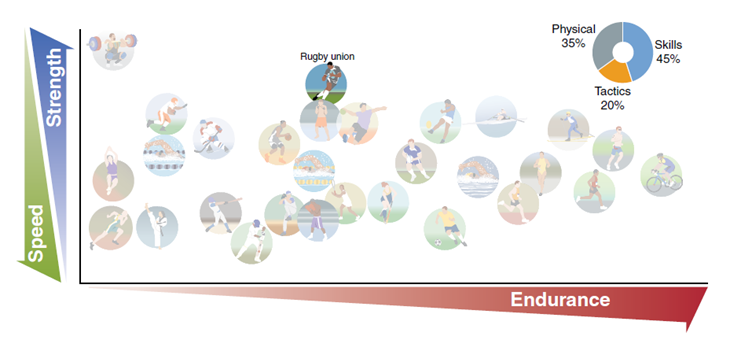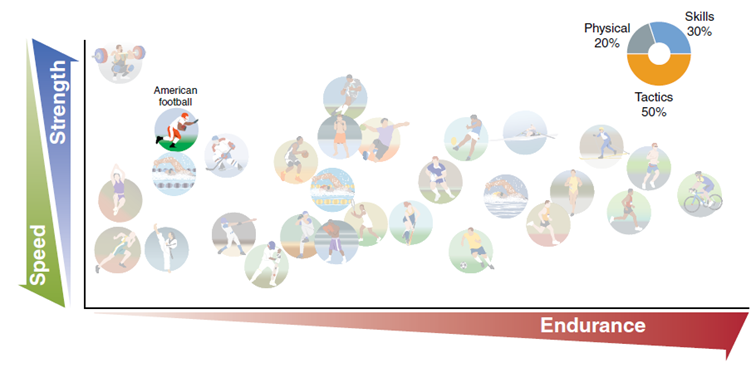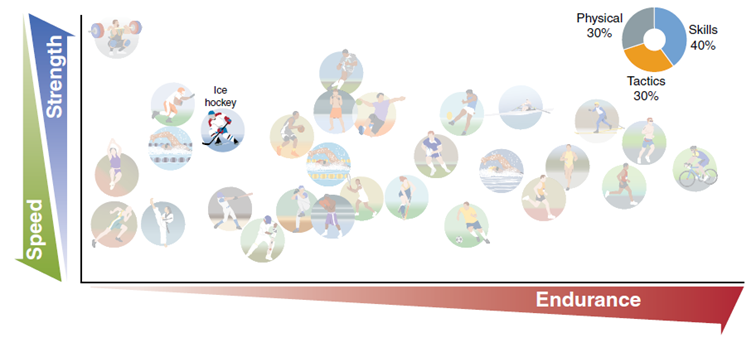
The Use of Plantar Pressure Mapping in Rugby, Ice Hockey, and American Football
Rugby, Ice Hockey, and American Football are three sports that fall into intermittent high-intensity activities.
Rugby, also known as Rugby Football or Rugby Union, is a contact sport mainly involving running with a ball in hand, with the primary objective of scoring more points than an opposing team.
A rugby player requires high levels of strength and the ability to express this strength repeatedly throughout the game. Skills and physical components account for 80% of the performance contributing factors. In contrast, tactical component results weigh less than sports such as football (soccer) or basketball (Fig. 1).
 Figure 1. The position of the rugby player on the three axes illustrates the relative importance of the three main physical capacities of importance for elite participation in rugby (from Laursen and Buchheit, "Science and Application of High-Intensity Interval Training, adapted from G.A. Nader, "Concurrent Strength and Endurance Training: From Molecules to Men", Medicine & Science in Sports & Exercise 38, no. 11 (2006): 1965-1970).
Figure 1. The position of the rugby player on the three axes illustrates the relative importance of the three main physical capacities of importance for elite participation in rugby (from Laursen and Buchheit, "Science and Application of High-Intensity Interval Training, adapted from G.A. Nader, "Concurrent Strength and Endurance Training: From Molecules to Men", Medicine & Science in Sports & Exercise 38, no. 11 (2006): 1965-1970).
American football is a contact sport predominantly played in North America, where it is one of the most popular disciplines.
It's a sport where players need high levels of speed, strength, power, and agility to accomplish the demanding physical tasks of repeated sprints and high-intensity efforts involving accelerations, decelerations, tackling, and impacts (Fig. 2).
 Figure 2. The position of the American football player on the three axes illustrates the relative importance of the three main physical capacities for elite participation in the sport (from Laursen and Buchheit, "Science and Application of High-Intensity Interval Training, adapted from G.A. Nader, "Concurrent Strength and Endurance Training: From Molecules to Men", Medicine & Science in Sports & Exercise 38, no. 11 (2006): 1965-1970).
Figure 2. The position of the American football player on the three axes illustrates the relative importance of the three main physical capacities for elite participation in the sport (from Laursen and Buchheit, "Science and Application of High-Intensity Interval Training, adapted from G.A. Nader, "Concurrent Strength and Endurance Training: From Molecules to Men", Medicine & Science in Sports & Exercise 38, no. 11 (2006): 1965-1970).
Lastly, ice hockey is a high-speed, discontinuous, and repeated-sprint sport, considered the fastest team sport in the world. Ice hockey players must sustain rapid and irregular changes in movement patterns, accelerations, decelerations, and high-speed collisions (Fig. 3).
 Figure 3. The position of the ice hockey player on the three axes illustrates the relative importance of the three main physical capacities of importance for elite participation in the sport (from Laursen and Buchheit, "Science and Application of High-Intensity Interval Training, adapted from G.A. Nader, "Concurrent Strength and Endurance Training: From Molecules to Men", Medicine & Science in Sports & Exercise 38, no. 11 (2006): 1965-1970).
Figure 3. The position of the ice hockey player on the three axes illustrates the relative importance of the three main physical capacities of importance for elite participation in the sport (from Laursen and Buchheit, "Science and Application of High-Intensity Interval Training, adapted from G.A. Nader, "Concurrent Strength and Endurance Training: From Molecules to Men", Medicine & Science in Sports & Exercise 38, no. 11 (2006): 1965-1970).
The Physical and Technical Demands of Rugby, Ice Hockey, and American Football
The first step to designing a proper testing process using plantar pressure mapping is to analyze the biomechanical requirements of each sport and their contribution to the overall performance and objectives of the game.
The three sports have in common the high-intensity and intermittent nature of the games, and all involve high levels of impact and high-speed collisions.
Furthermore, due to the peculiar nature of the playing surface, ice hockey players need to show different biomechanics characteristics to apply force on the ice surface while balancing on the blade and dealing with the increased eccentric strength demands due to the lack of friction on the ice.
Plantar pressure mapping technology has the potential to highlight subtle biomechanical faults showing up at the point of contact between the plantar surface of the foot and the ground, such as pressure distribution, center of pressure trajectory, and force-time curves. These metrics can provide information on how the player transmits forces during acceleration, deceleration, landing, and rapid changes in direction or movement patterns.
Plantar Pressure Mapping Testing
In rugby, power, speed, and repeated sprint ability represent fundamental qualities, and the following tests can be performed to assess those qualities:
- Vertical jump
- 40 m sprint test
- 6x30 m repeat sprint ability test
In ice hockey, on-ice testing for speed is usually performed over a distance of 30 to 35 m. However, it still needs to be determined what the characteristic distance to measure acceleration and speed capabilities in ice hockey players (Stastny et al., 2023) is.
Vertical jump and 40-yard tests are part of the NFL (National Football League) combined process to assess leg power production and acceleration capabilities in American football.
Adding plantar pressure mapping insoles to the testing procedure in these contexts allows us to go beyond the quantitative analysis to gain a detailed insight into the quality and efficiency of movement.
This is a fundamental leap in the work of strength and conditioning coaches and sports rehabilitation professionals trying to optimize performance, identify injury risks, and monitor the rehabilitation process.
To learn more about using plantar pressure mapping technology to build a player pressure profile in rugby, ice hockey, and American football, and how to use plantar pressure mapping software to analyze data, watch the fourth part of the Plantar Pressure Mapping in Team Sports webinar series, 'How to Profile Rugby, Ice Hockey, and American Football Players with XSENSOR's Intelligent Insoles.'
References
- Higham DG et al., Rugby Union Players in Physiological Tests for Elite Athletes. 2013. Human Kinetics 2nd ed.
- Laursen and Buchheit, Science and Application of High Intensity Interval Training. 2019. Human Kinetics.
